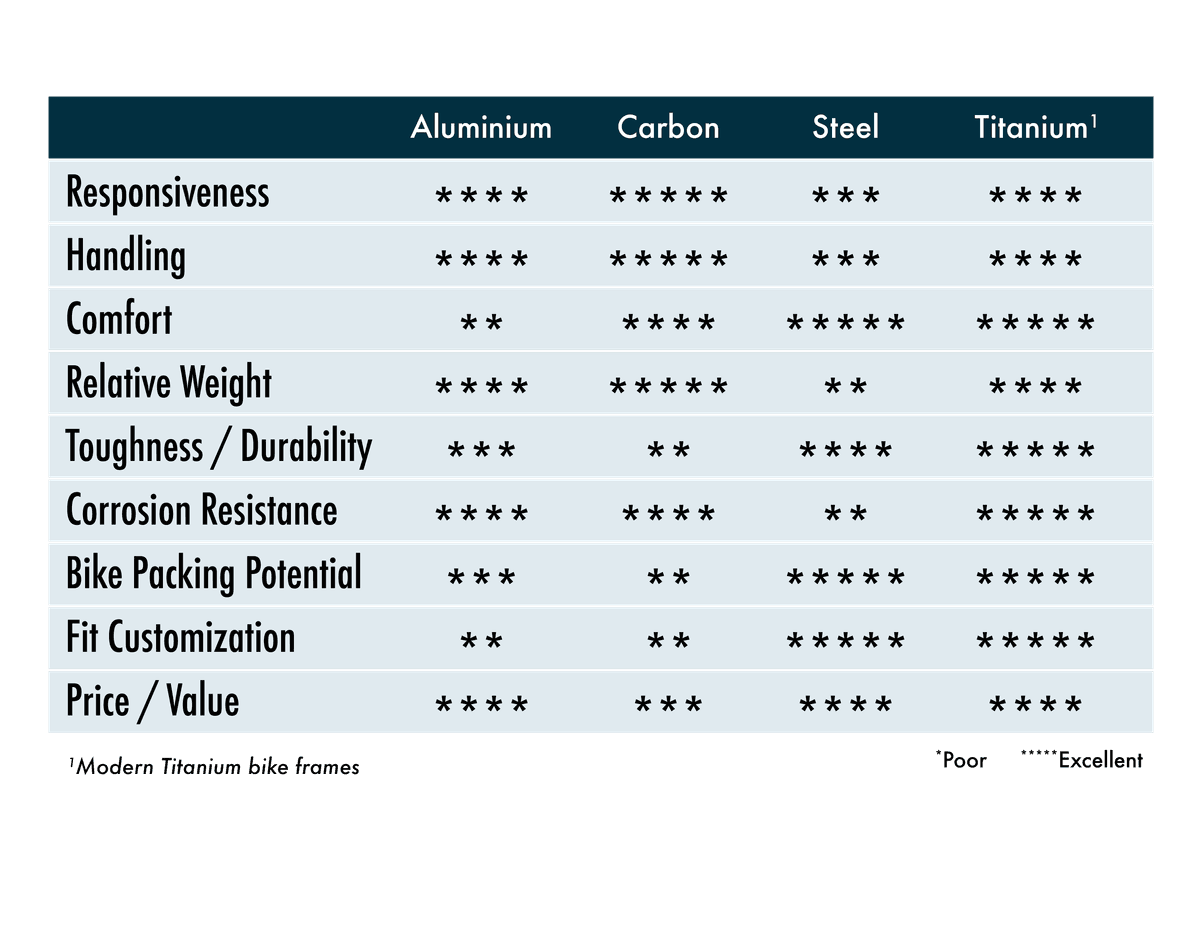
TITANIUM GRAVEL BIKE - QUIVER KILLER?
July 29, 2022
A single bike to do it all, and do it well. The holy grail of bicycle ownership. While many have succumbed to the N+1 mentality, the rising cost of quality bikes — and the real estate needed to store them — is bringing an increasing number of cycling enthusiasts to seek a singular solution. The bike industry has responded in kind, with a growing array of all-around models and any-road offerings. Which one is best? The carbon road bike? Titanium gravel bike? Steel hardtail? Allow us to guide you through the possibilities by process of elimination. We begin by considering the type of bike.
When it comes to all-around performance and utility, some bicycle genres are easy to rule out. For instance, you’ve got to love the simplicity of the single speed, but it loses its allure off the street. On the other side of the scale, a full-suspension MTB is the only way to go when riding the gnarliest of mountain trails, but would represent nobody’s first choice on a long, group ride (on the tarmac). Its predecessor, the hardtail, is a more viable all-terrain option, as it offers more versatility on and off the road. That said, it falls short as compared to some other bike types when pure speed, handling and climbing performance are required. With those core qualities in mind, we must look towards the middle of the bicycle spectrum to find our top contenders.
In this corner: hailing originally from Germany, weighing-in (in some cases) at or even below the UCI limit… the road bike. Cycling trends come and go; the road bike persists as the flagship of the cycling industry. This continued relevance is rooted in performance – nothing accelerates, corners and climbs quite like a top-notch road machine, – and an evolution towards more endurance-oriented configurations. The modern road bike can go fast and long, while also accommodating wider tires (up to 700 x 35c) to expand its utility off the smooth pavement. That said, when the terrain gets rougher and the traction more difficult to come by, the road bicycle loses the lead position to a relative newcomer.
Developed in the 1990s in the United States, the gravel bike was the response to the all-terrain inadequacies of the road bike, along with the overly aggressive stance and tire limitations of the cyclocross bike. Essentially, the gravel bike was brought to life by the need for wider tires and a slacker, more relaxed geometry that could offer better stability and allow riders to more comfortably sustain their position over extended multi-terrain rides. Moving forward, today’s gravel bike features a more compact wheelbase and allows for double chainring (2x) setups, making it a more-than-capable endurance road bike when using smaller-scale tires (i.e. 700 x 28c). Where the gravel bike really stands apart is on the loose stuff, where its more stable platform, combined with tires upwards of 700 x 40c (or 50 x 650b), allows it to emerge as the superior mixed terrain option. All told, if you’re looking for a one-bike-quiver, the gravel bike stands alone.
So, what kind of gravel bike? What frame material is ideal for an all-terrain, adventure machine?
Every bike frame material has its relative merits; we all have our history in that regard and resulting preferences. When it comes to the best stuff to make a gravel bike frame, in order to attempt as objective an evaluation as possible, we need to put forth some key criteria:
- RESPONSIVENESS - A gravel bike’s capacity to accelerate as soon as the rider pushes on the pedal, regardless of the surface.
- HANDLING - Manoeuvrability and predictability in the turns and around off-road obstacles. This is primary determined by the geometry of the frame.
- COMFORT - A good gravel bike frame performs while effectively absorbing excessive road vibrations and bumps.
- TOUGHNESS / DURABILITY - Impact resistance is fundamentally important when the rocks are flying around and the top-loaded tumbles are more probable. So is the capacity to maintain mechanical properties over the long haul. These characteristics, when combined, have a direct impact on the longevity of the bike and, by extension, its environmental sustainability.
- RELATIVE WEIGHT - The lighter a bike, the easier the climbing … and the carrying around. That said, this characteristic is somewhat offset when it comes to a gravel bike by the greater need for durability.
- CORROSION RESISTANCE - A better gravel bike is weatherproof; it can resist deterioration due to exposure to the various elements that tend to be more prevalent on a gravel ride.
- BIKE PACKING POTENTIAL - A gravel bike frame’s capability to securely integrate various mounts for lugging the provisions and stuff you’ll need on a two-wheeled adventure.
- FIT CUSTOMIZATION - The ability to perfectly dial-in the frame size / geometry to foster a more sustainable riding position and avoid the potential toe overlap issues brought about by larger tires.
- PRICE / VALUE – An affordable gravel bike is good; a gravel bike that can deliver the goods long-term and hold its value is much better.
Based on the aforementioned criteria for selecting the optimal gravel bike, here is how the main bike frame materials fare:

Coming out of the gate, carbon gravel bikes tend to receive lead consideration given the material’s inherent reputation for lightweight performance. When you also take into account core attributes like durability and comfort, – which are even more important for gravel biking – and you factor in the aspects of long-term value and sustainability, the titanium gravel bike emerges as the clear winner. It’s why most gravel cyclists in the know today have a preference for titanium. As the public educates itself on the advantages and disadvantages of the different bicycle frame materials, you can expect to see more and more people choosing a titanium gravel bike as their one and only riding partner.
